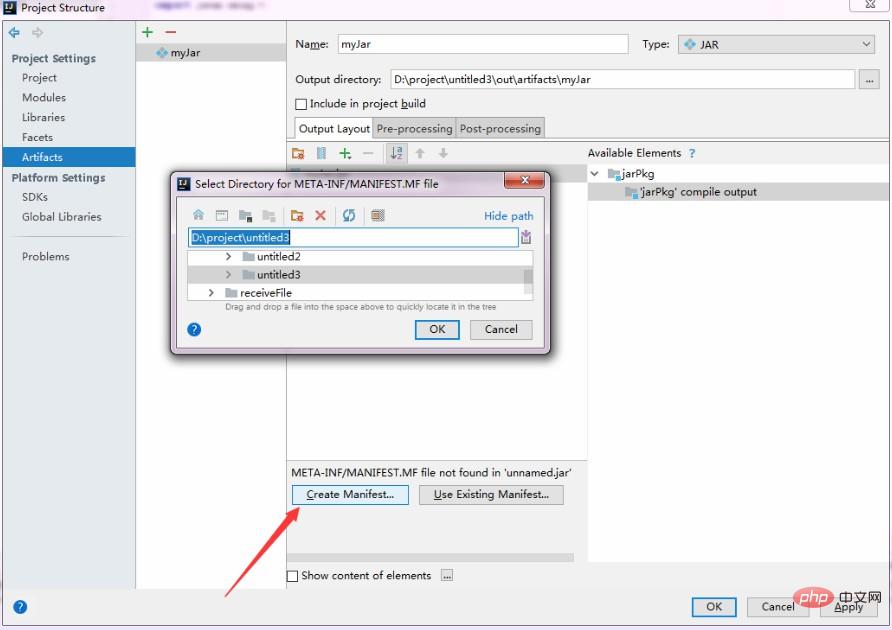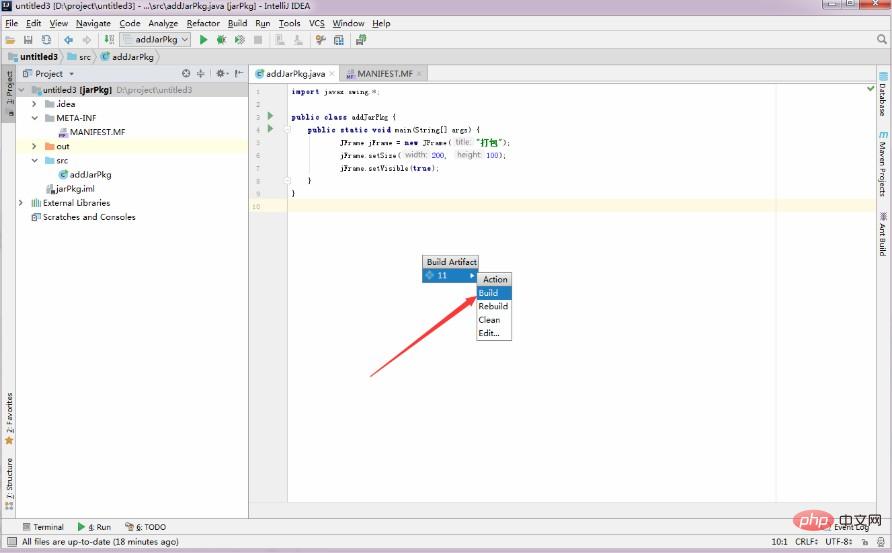How to package Java

How to package java
1. Manually create a directly executable jar package
1) First use javac to compile the java file and get the class file
2) Create a new file with any name, for example, it can be called manifest, and the content is as follows
Manifest-Version: 1.0 Main-Class: addJarPkg
(Note: 1 . Add a space after the colon, 2. Finally, you must press Enter to a new blank line, otherwise an error will occur. For example, as shown below, you must enter another Enter after addJarPkg)
3) Put the compiled class file Put the newly created file in step 2 into the specified folder, such as test
4) Run the command
jar -cvfm main.jar manifest -C test .
in cmd. Pay attention to the path problem, where
The "." after test represents all files
The -m option after jar will merge the files created in step 2 into META-INF/MANIFEST.MF in the jar package, which is to update the manifest configuration document. -C specifies the directory to be packaged, and the . after the directory represents all the files in the directory
2. Use the intellij idea tool to create a directly executable jar package
1 ) Click on Project
2) Click on the "File" menu in the upper left corner of intellij idea -> Project Structure
3) Click on "Artifacts" -> Green " " -> "JAR " -> Empty
4) Fill in the custom name in the Name column, select the jar package target directory in Output dictory, and double-click the file that needs to be added to the jar package in Available Elements to add it to the jar package on the left directory, see the picture below for details
 5) Click Create Manifest and select the file path where MANIFEST.MF is placed (just default to the project root directory. Try not to choose other paths, which may cause unnecessary error), click OK.
5) Click Create Manifest and select the file path where MANIFEST.MF is placed (just default to the project root directory. Try not to choose other paths, which may cause unnecessary error), click OK.
 6) Click the selection button behind Main Class
6) Click the selection button behind Main Class
7) In the pop-up box, select the program entry main function that needs to be run, and click OK
8) After the above settings are completed , click OK
9) Click "Build" in the menu -> "Build Artifacts"
10) Double-click the build under the jar package to be generated in the pop-up box, as shown below
 At this point, use Intellij idea to generate a jar package that can be directly executed.
At this point, use Intellij idea to generate a jar package that can be directly executed.
php Chinese website, a large number of free Java introductory tutorials, welcome to learn online!
The above is the detailed content of How to package Java. For more information, please follow other related articles on the PHP Chinese website!

Hot AI Tools

Undresser.AI Undress
AI-powered app for creating realistic nude photos

AI Clothes Remover
Online AI tool for removing clothes from photos.

Undress AI Tool
Undress images for free

Clothoff.io
AI clothes remover

AI Hentai Generator
Generate AI Hentai for free.

Hot Article

Hot Tools

Notepad++7.3.1
Easy-to-use and free code editor

SublimeText3 Chinese version
Chinese version, very easy to use

Zend Studio 13.0.1
Powerful PHP integrated development environment

Dreamweaver CS6
Visual web development tools

SublimeText3 Mac version
God-level code editing software (SublimeText3)

Hot Topics
 1359
1359
 52
52
 Square Root in Java
Aug 30, 2024 pm 04:26 PM
Square Root in Java
Aug 30, 2024 pm 04:26 PM
Guide to Square Root in Java. Here we discuss how Square Root works in Java with example and its code implementation respectively.
 Perfect Number in Java
Aug 30, 2024 pm 04:28 PM
Perfect Number in Java
Aug 30, 2024 pm 04:28 PM
Guide to Perfect Number in Java. Here we discuss the Definition, How to check Perfect number in Java?, examples with code implementation.
 Random Number Generator in Java
Aug 30, 2024 pm 04:27 PM
Random Number Generator in Java
Aug 30, 2024 pm 04:27 PM
Guide to Random Number Generator in Java. Here we discuss Functions in Java with examples and two different Generators with ther examples.
 Armstrong Number in Java
Aug 30, 2024 pm 04:26 PM
Armstrong Number in Java
Aug 30, 2024 pm 04:26 PM
Guide to the Armstrong Number in Java. Here we discuss an introduction to Armstrong's number in java along with some of the code.
 Weka in Java
Aug 30, 2024 pm 04:28 PM
Weka in Java
Aug 30, 2024 pm 04:28 PM
Guide to Weka in Java. Here we discuss the Introduction, how to use weka java, the type of platform, and advantages with examples.
 Smith Number in Java
Aug 30, 2024 pm 04:28 PM
Smith Number in Java
Aug 30, 2024 pm 04:28 PM
Guide to Smith Number in Java. Here we discuss the Definition, How to check smith number in Java? example with code implementation.
 Java Spring Interview Questions
Aug 30, 2024 pm 04:29 PM
Java Spring Interview Questions
Aug 30, 2024 pm 04:29 PM
In this article, we have kept the most asked Java Spring Interview Questions with their detailed answers. So that you can crack the interview.
 Break or return from Java 8 stream forEach?
Feb 07, 2025 pm 12:09 PM
Break or return from Java 8 stream forEach?
Feb 07, 2025 pm 12:09 PM
Java 8 introduces the Stream API, providing a powerful and expressive way to process data collections. However, a common question when using Stream is: How to break or return from a forEach operation? Traditional loops allow for early interruption or return, but Stream's forEach method does not directly support this method. This article will explain the reasons and explore alternative methods for implementing premature termination in Stream processing systems. Further reading: Java Stream API improvements Understand Stream forEach The forEach method is a terminal operation that performs one operation on each element in the Stream. Its design intention is




